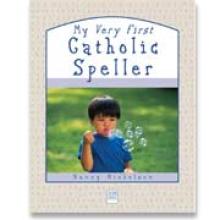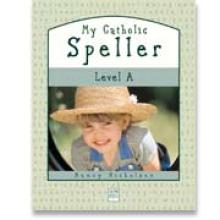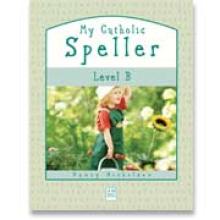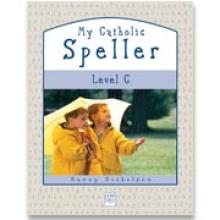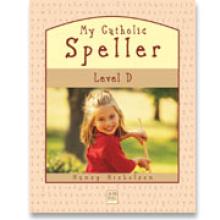No name
My Very First Catholic Speller
This charming work text is designed to precede the My Catholic Speller series and would be appropriate for most First Graders. The book provides 27 two page lessons with six spelling words each. Spelling words include some Catholic words as well as the basics. Lessons provide opportunities for simple writing exercises (on appropriate sized writing lines with dotted center-lines as well as simple exercises in matching words and pictures, finding rhyming words, making up sentences, finding hidden words, simple alphabetization, etc. List words are grouped by vowel sounds, phonograms and simple spelling rules. The Introduction provides a simple outline for completing a lesson each week and a segment at the end of the book entitled "Presenting the Lesson" gives teaching tips and ideas for each lesson. The book also comes with an alphabet on heavy cardstock to cut out for a simple way that children can start putting letters together into words.
Copyrights 2001/2003
Donated for review by Catholic Heritage Curricula
My Catholic Speller (Level A)
I've always loved the simplicity and elegance with which Nancy Nicholson combines simple spelling lessons with lovely Catholic content. This content helps children make real connections between their faith and everyday life. My young children, especially, love the beautiful, colorful new covers and are even more receptive to the gentle style of these lessons.
Highlights of the series include word searches, crossword puzzles and the incorporation of short biblical apologetics lessons. I have run into many homeschool moms - even those who aren't generally inclined to use workbooks - who really like this program because of its beauty and simplicity. One helpful suggestion to reinforce phonics lessons, is to have children circle the phonograms in each of their spelling words when they first begin to study them.
First Lesson Word List: at, sat, hat, an, and, man, hand, am, Adam, Mass, is, it, hot, pot, stop
Final Lesson Word List: squeeze, squash, square, pineapple, sunshine, stoplight, pickup, bedtime, cupcake, sidewalk, downtown, upstairs, baseball, sailboat, campfire
This book is intended for the second grade.
Copyrights 1998/2003
Donated for review by Catholic Heritage Curricula
My Catholic Speller (Level B)
This third grade spelling workbook incorporates fun word searches, crossword puzzles and other puzzles into gentle spelling lessons while elegantly tying in Catholic content. Dictionary work, fill-in-the blanks and some traditional spelling practice are also included.
This is the first book in the series to offer short biblical quotations in most lessons that can be used for memory or copywork and are coordinated with a segment for apologetics lessons in the back of the book, called "Scriptural Answers for Every Catholic Kid". For example, week twenty offers this quotation: "...but of that day or hour, no one knows, not even the angels in Heaven, nor the Son, but only the Father..." (Mark 13:32) The segment in back is a little more extensive:
Week Twenty: Jesus' Return False teaching: Numerous cult leaders have set dates, most of which have come and gone, for Jesus' return. Counter with: "...but of that day or hour, no one knows, not even the angels in Heaven, nor the Son, but only the Father..." (Mark 13:32)First Lesson Word List: job, fog, frog, rock, cross, drop, modest, long, land, add, after, baptism, hang, rang, flag Final Lesson Word List: hotter, hottest, sadder, saddest, sadden, gladden, bigger, biggest, rotten, hidden, happens, wetter, dimmer, sinner, fatten
An answer key is included in the back of the book. The book offers 34 weekly lessons, including a review lesson for each quarter.
Copyrights 1998/2003
Donated for review by Catholic Heritage Curricula
My Catholic Speller (Level C)
Level C, intended for use with fourth graders, incorporates a variety of fun and creative techniques to learn spelling words in 34 weeks of lessons. New list words are presented in both cursive and print. Crossword puzzles, fill-in-the blanks, dictionary work and word searches complement the recommended oral study, mid-week quiz and final test. Catholic content is elegantly woven into the text, helping children make connections between their faith and other subjects. Most notably, the "Scriptural Answers for Every Catholic Kid" provides regular memory and copywork with further details in back to create mini apologetics lessons.
First Lesson Word List: bell, smell, spell, mess, doll, egg, kettle, blend, twelve, Advent, lamp, fast, mantle, bank, past
Final Lesson Word List: photo, prophets, cough, laugh, orphan, enough, graph, stiff, Joseph, geography, nephew, suffix, rough, alphabet, gruff
An answer key is included in the back of the book. The book offers 34 weekly lessons, including a review lesson for each quarter.
Copyrights 1999/2005
Donated for review by Catholic Heritage Curricula
My Catholic Speller (Level D)
This grade five worktext provides 34 lessons of spelling words with a review lesson each quarter. Approximately 20 list words are presented each week, in cursive writing, and many creative ways of practicing the words keep the lessons interesting. Apologetics lessons this year focus on quotes from the Fathers of the Church.
First Lesson Word List: valid, with, bishop, ministry, trip, craft, drill, cast, grip, limp, camp, dissent, gland, disturb, tickle, gather, visit, dampen, paten, Latin Final Lesson Word List: fright, brought, brighten, heirs, height, bough, finger, heavy, fight, hundred, insight, delight, slight, drought, catch, caught, seek, sought, teach, taught
An answer key is included in the back of the book.
Copyrights 2000/2003/2005
Donated for review by Catholic Heritage Curricula
My Catholic Speller (Level E)
Level E is the 5th-6th grade text in this series, providing 34 weeks of spelling lessons with quarterly reviews. The book is now bound with a lay-flat spiral binding, making it easier for the student to write in the book. Spaces for the student's work include a dashed middle line, allowing for handwriting practice–-an important and overlooked element in teaching spelling. The particular copy of the text that I have is printed on a smooth, erasable, bright-white paper, but there is some show-through of the ink from the printing on the other side of the paper. I find it distracting, but my son hasn't been bothered by it.
The list words for the first 15 weeks are grouped by phonogram, while the next 15 weeks' lists concentrate on prefixes and suffixes. The final lessons teach homonyms and some Greek and Latin roots. Week 3 includes these words: muscle, scissors, grasp, genuflect, and produce. Week 14 includes these words: parachute, clutch, ancient, gesture, and challenge. Week 25 includes these words: beautify, devotee, stigmatist, volunteer, and author. Week 33 (the final lesson with new words) includes these words: precede, construct, vocation, structure, and recess. Exercises for each lesson include dictionary work, alphabetization, synonym and antonym practice, and some puzzles. This text, in contrast to many other series, emphasizes the meanings of the list words and their usage in sentences.
A unique feature of this series of spelling texts is the apologetics quote for each lesson that incorporates at least one of the list words. This grade level uses quotations from the early Church fathers, many of which I found very difficult! These quotations provide an excellent source for copywork and handwriting practice. Includes teaching suggestions and a full answer key bound into the back.
Copyrights 2001/2005
Donated for review by Catholic Heritage Curricula
My Catholic Speller (Level F)
This text, designed for the 6th-7th grade student, contains lessons for 34 weeks, including 4 quarterly review weeks, an answer key, and teaching instructions. The list words for the first 6 weeks review the various vowel and vowel phonogram sounds in new word lists, and the next 16 weeks focus on prefixes, suffixes, and some spelling trouble spots. The final word lists are devoted to derivatives of Latin and Greek roots, and one lesson on foreign words used in English. The word list for Week 1 is as follows: scrap, scrape, inflate, Africa, betray, clasp, agony, stable, traitor, blaze migrate, obtain, habitat, dedicate, restrain, manna, avid, vast, elevate, and disdain. The word list for Week 34 (the final review) is: mortal, petite, sympathetic, mosquito, vacant, volcano, infinity, suspect, apathy, graduate, dictator, mortify, insect, genetics, provision, invalid, congratulate, valor, multiple, and assist.
The winning apologetics feature of this series is continued in this level. The focus of the quotations from the Early Church Fathers is on Mary and her role in salvation history. Each week the quotation is used for copywork or memory work, or both, and usually contains at least one of the list words. The text includes teaching notes and explanations for each quotation in the back of the book. If you have done as the author suggests and kept an index card file labeled with a topic and the quotation, you will a wonderful apologetics library by the time that you complete the spelling series! Apologetics lessons are a feature of levels B-F.
Copyrights 2002/2003
Donated for review by Catholic Heritage Curricula
The Journal of Ben Uchida
The story helps the reader to understand certain truths about the camps and the consequences of having such camps;
Many of the prisoners, particularly the children were every bit like other Americans in their loyalties, interests and lifestyles and didn't identify with Japan at all.
The camps were a very difficult place to raise children and tended to cause a decline in morals and traditions among the people. A few examples: because the living quarters are so small (one room usually divided with a blanket to accomodate two families), the children roam fairly freely about the camp, allowing for such situations as this: the main character and another boy sneak off to try to see some "naked girls" changing for a play (they are unsuccessful). As far as traditions go, it is very sad to learn that the very traditional Japanese mothers and grandmothers are forced to wear pants because the dust and wind make dresses unmanageable.
The overall injustice of the situation is clearly portrayed as well. Before they leave for the camps, families are forced to sell nearly all of their belongings at ridiculous prices (the author does also introduce us to some kind neighbors and friends who help these families in various ways, such as storing furniture for them). Some of the fathers are taken away for a time to a separate camp because the government thinks they might have specific connections with the Japanese.
After I read the book, I was at first struck that it was very depressing. All of the bad things that happen are not alleviated by a hope in God or even a hero figure on a natural level. Ben Uchida is merely recording the way things are, rather than reflecting on them (with the exception of becoming somewhat cynical). It finally struck me that what the author has done is portray many of the major aspects of the hardships of the internment camp through the eyes of one boy and have all of the different sorts of problems occur within his close circle of friends. I believe that this is somewhat unrealistic and that the book should be read by children old enough to understand this concept. Other than that (and the objectionable incident mentioned above) it really does give the reader a sense of the significance of this terrible event in American history which - even in the politically correct climate of modern America - is largely ignored. The Historical Note section (17 pages) is quite interesting. It includes some factual information about the camps, a number of black and white photos, and a brief history of the treatment of Chinese and Japanese in America (and particularly the discriminatory laws aimed against them over the years). It is also interesting that Franklin Roosevelt (who is so admired by "the left" today) is quite fairly criticized for committing such a crime against American citizens (by Executive Order) and it is interesting that it was Ronald Reagan who attempted to make some sort of retribution (however inadequate) to the Internment Camp survivors.
Our Quest for Happiness
I was introduced to the series as a high school freshman. I enjoyed the text very much at that time (even though I was working with a photocopy). I was equally impressed with the Sophomore text when I taught with it nearly ten years later.
The first book, Our Goal and Our Guides, focuses on understanding our goal in life – attaining Heaven – and spiritual and doctrinal issues that are related to that goal (such as the roles of faith and reason, the liturgical year, the Blessed Trinity, the Fall, and Salvation through Christ).
The second book, Through Christ Our Lord, studies the life of Our Lord in great detail - covering the Old Testament time of waiting for Christ, the basic events of Christ's life, a detailed study of Christ's Death and Resurrection, the Eucharist and the Mass, the Sacraments and following Christ today.
The Ark and the Dove (Book Three) covers the Catholic Church and the Holy Spirit.
Towards the Eternal Commencement is designed especially to prepare graduating seniors as they go out into the world. It covers Our Lady; considerations about death and the afterlife (best reflected upon earlier in life!); vocations; those commandments, virtues and teachings important for "building a better world" and a segment on Apologetics.

